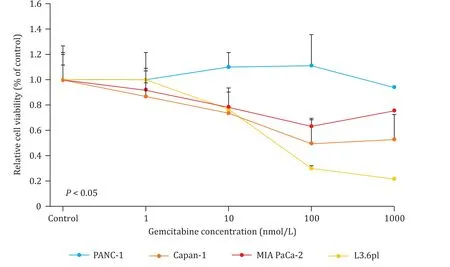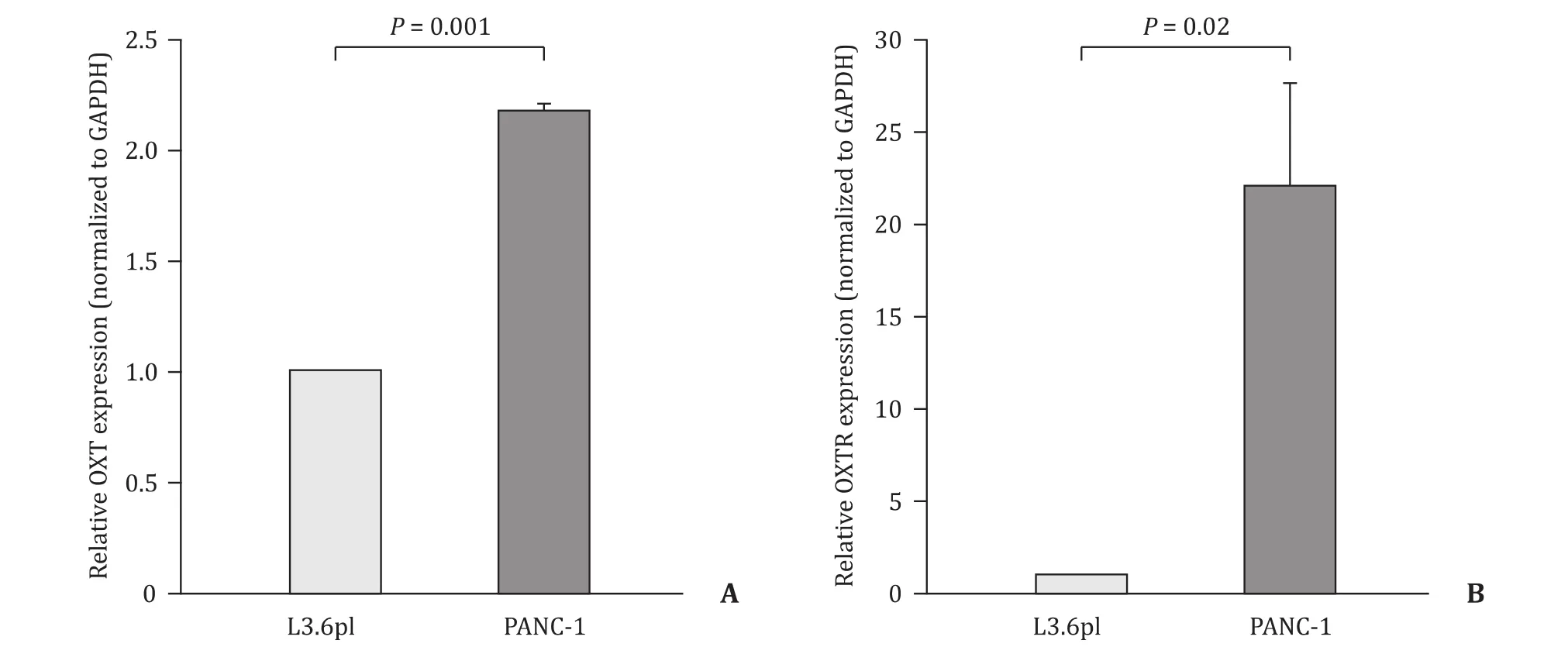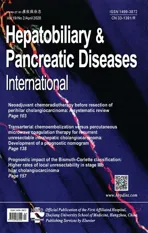Oxytocin and oxytocin receptor alterations, decreased survival, and increased chemoresistance in patients with pancreatic cancer
2020-05-10TrisheenaHarricharranOlorunseunOgunwobi
Trisheena Harricharran , Olorunseun O. Ogunwobi , d , *
a Department of Biological Sciences, Hunter College of The City University of New York, New York, NY 10065, USA
b The Graduate Center Departments of Biology and Biochemistry, The City University of New York, New York, NY 10016, USA
c Hunter College Center for Cancer Health Disparities Research (CCHDR), New York, NY 10065, USA
d Joan and Sanford I. Weill Department of Medicine, Weill Cornell Medicine, Cornell University, New York, NY 10065, USA
ABSTRACT
Keywords:
Oxytocin
Oxytocin receptor
Pancreatic cancer
Introduction
Pancreatic cancer (PC) remains one of the most devastating cancers with a poor prognosis [1] . Pancreatic ductal adenocarcinoma(PDAC) is the most common type of PC, and it is the fourth leading cause of cancer-related deaths in the United States [2 , 3] . More than 70% of patients die within the first year of diagnosis with PC,and the 5-year survival rate is only 8% [4 , 5] . PC is commonly diagnosed at advanced, already metastatic stages where most patients will rely on chemotherapy. However despite extensive research efforts in recent decades, PC remains resistant to almost all clinically available therapeutic regimens [6 , 7] .
Oxytocin (OXT) is a nine-amino acid peptide hormone synthesized mainly in the hypothalamus and secreted into the bloodstream [8] . OXT is well known for its importance in the female reproductive system, mainly during pregnancy and lactation [9] .Although originally thought to be limited in its role to the female reproductive system, further research revealed that OXT also plays an important role in the male reproductive system [10-13] . In addition to physical function, it is now better understood that OXT also plays a major role on social behaviors, such as stress and trust,anxiety, social interaction and bonding, and parental care [14-17] .OXT also plays role in neuropsychiatric disorders which are linked to these social behaviors [18] . Additionally, emerging evidence has linked OXT to cancer. The OXT peptide is synthesized as an inactive precursor protein from theOXTgene and gets activated upon bonding to the OXT receptor (OXTR), a G-protein coupled receptor [8] . Recent findings have shown that OXT promotes cell proliferation in breast, prostate, osteosarcoma, and lung cancers [19-27] .OXT binds to its receptor which activates MAPK cascade and results in ERK1/2 phosphorylation and cell proliferation [8 , 28] . OXT is a possible candidate in PC chemoresistance as it regulates apoptotic pathways via MAPK cascade [29] .

Fig. 1. OXT and OXTR genetic alterations and gene expression changes in pancreatic cancer (PC). Both OXT ( A ) and OXTR ( B) were altered in 9 (5%) out of 185 PC cases/patients.OXT: oxytocin; OXTR: oxytocin receptor.
PC is frequently characterized by genetic alterations, but it should be noted that a single gene activation is not responsible for the conversion between cancer and non-cancer states [30] . In fact,to develop PC, multiple genetic alterations must be accumulated in a single cell. Such alterations include overexpression of receptorligand systems, oncogene activation, and loss of tumor suppressor genes [30] . To our knowledge, no previous studies have tried to explore the correlation ofOXTandOXTRgenetic alterations and gene expression changes with clinical features in PC. This study explored the genetic alterations and gene expression changes ofOXTandOXTRin PC from the Cancer Genome Atlas (TCGA) data sets which contains information on DNA, RNA, proteins, and survival status in various cancers using the cBioPortal online platform as an analysis tool. Additionally, we investigated the correlation of these changes with clinical outcomes.
Methods
Gene expression databases
The cBioPortal for Cancer Genomics ( http://cbioportal.org ), a web resource for exploring, visualizing, and analyzing multidimensional cancer genomics data was used to retrieve information regardingOXTandOXTRgenetic alterations or changes in gene expression (mutations, putative copy-number alterations, mRNA expression, and protein expression) in PC. To visualize and analyze the genetic alterations or changes in gene expression ofOXTandOXTRin the TCGA PC cases, several options were selected in the web interface of cBioPortal. The cancer study “pancreatic adenocarcinoma (TCGA)”“mutation”“CNA (DNA copy-number alterations)”“mRNA expression”and “protein expression”were the data type priority selected. For the gene set of interest, terms of “OXT”and“OXTR”were entered in the input box. Informed consent or statements of approval were not required for this study because the data was obtained from an open-access database.
Genetic alterations and gene expression change summary
The genetic alterations and gene expression changes of theOXTandOXTRin tumor samples are summarized in an Onco-Print in Fig. 1 . Glyphs and color coding were used to summarize genomic alterations, including mutations, CNA (amplifications and homozygous deletions), and changes in gene expression.
Survival analysis
If survival data were available, overall survival and disease-free survival differences were compared between samples with theOXTalteration and those without. The same was done between samples with and withoutOXTRalteration. It should be noted that mRNA expression data was not available for all 185 samples. However,this discrepancy was taken into consideration in all analyses done.
Cell culture
Human pancreatic ductal adenocarcinoma (PDAC) cell lines PANC-1, MIA PaCa-2, Capan-1, and L3.6pl were used in this study.PANC-1 was purchased from the American Type Culture Collection(ATCC), USA. L3.6pl was obtained as a gift from Dr. Jose Trevino’s laboratory in the Department of Surgery, University of Florida(Gainesville, FL, USA). MIA PaCa-2 and Capan-1 were gifts from Dr.David Foster’s laboratory at the City University of New York. PANC-1 and MIA PaCa-2 cell lines were routinely cultured in Dulbecco’s Modified Eagle’s Medium (DMEM) with non-essential amino acids from Corning (Manassas, VA, USA) and 10% fetal bovine serum(FBS). Capan-1 cell line was routinely cultured in Iscove’s Modified Dulbecco’s Medium (IMDM) with L -glutamine from Gibco by Life Technologies (Green Island, NY, USA) and 20% FBS. L3.6pl cells were cultured in DMEM with non-essential amino acids and sodium pyruvate from Corning and 10% FBS. All cell lines were maintained as adherent cultures at 37 °C in a humidified atmosphere containing 5% CO 2 .
RNA isolation and quantitative real-time polymerase chain reaction(qRT-PCR) analysis
Total RNA was extracted from cell lines using the RNeasy Mini Kit (Qiagen, Hilden, Germany). cDNA synthesis and qRT-PCR were performed as previously described [31] . Briefly, extracted RNA was quantified with Nanodrop10 0 0 spectrophotometer from NanoDrop (Madison, WI, USA). One μg of RNA was reversetranscribed into cDNA using QuantiTect Reverse Transcription kit from (Qiagen). qRT-PCR was performed using SYBR Green to examine the mRNA expression levels ofOXTandOXTR. Reactions were conducted in a 96-well spectro fluorometric thermal cycler ViiATM 7 real-time PCR system from Life Technologies.OXTandOXTRexpressions were normalized withGAPDHexpression within each sample. The comparative cycle threshold (C t )method was used for the relative quantification of the expression of the target genes. The following qPCR primer sequences were used: forward humanOXT: 5 ′ TTGAACAGAGCTCCACCGAC3’;reverse humanOXT: 5 ′ TCTTCCGCGCAGCAGATATT3’; forward humanOXTR: 5 ′ CCTTCATCGTGTGCTGGACG3’; reverse humanOXTR: 5 ′ CTAGGAGCAGAGCACTTATG3’; forward humanGAPDH:5 ′ GAGTCAACGGATTTGGTCGT3’ and reverse humanGAPDH:5 ′ TTGATTTTGGAGGGATCTCG3’. All primers were purchased from Sigma (St. Louis, USA).

Fig. 2. Overall survival Kaplan-Meier estimate in pancreatic cancer. The impacts of OXT (A) and OXTR (B) alterations. OXT: oxytocin; OXTR: oxytocin receptor.
Western blot analysis
Western blot was performed as previously described [32] .Twenty μg of cell lysate was used and 5% BSA for blocking. Primary antibodies used were against OXTR (1:500): ab2413 (Abcam plc,Cambridge, UK), and beta-actin (1:10 0 0): a5441 (Sigma-Aldrich, St.Louis, USA). Secondary antibodies against mouse or rabbit were used (Sigma-Aldrich). Li-COR Odyssey CLx with infrared fluorescence, IRDye secondary antibodies (1:15,0 0 0) and imagers were also used to detect Western blots. Odyssey imager, Image Studio version 5 was used to analyze and quantify Western blots.
Cell viability assay
Cell viability was determined using the 3-(4,5-dimethylthiazol-2-yl) -2,5-diphenyltetrazolium bromide (MTT) colorimetric assay,as previously described [33] . Briefly, PANC-1 and L3.6pl cells were dispensed into 96-well plates at a density of 20 0 0 per well and incubated for 72 h at 37 °C with gemcitabine (10-10 0 0 nmol/L). Controls were cells incubated with the dissolvent 0.01% DMSO. Sample absorbance was analyzed using a SpectraMax i3x Multi-Mode Microplate Reader at 490 nm. All experiments were done in at least duplicates.
Statistical analysis
Kaplan-Meier plots with a log-rank test were used to compare overall survival and disease-free survival in the pancreatic adenocarcinoma cases. This comparison was done between cases with at least one alteration or without alteration in the query gene(s).A threshold ofZ>2 (mean expression over 2 standard deviations)was used to identify samples with over expression. Thealevel was set at 0.05.
All experimental data were expressed as the mean ±standard error of the mean (SEM). To compare two groups, a double-sided Student’st-test was used. Two-way ANOVA was used when comparing more than two groups. The null hypothesis was rejected at the 0.05 level.
Results
TCGA dataset analysis of OXT and OXTR genetic alterations and gene expression changes with overall survival and disease-free progression months
To determine the genetic alterations or gene expression changes ofOXTandOXTRgenes we used the cBioPortal platform (cbioportal.org) which indicates that 5% (9 out of 185) of the sequenced PC cases/patients have genetic alterations or changes in gene expression inOXTandOXTRgenes, respectively ( Fig. 1 ). TheOXTgene expression changes were all by an upregulation in oxytocin mRNA( Fig. 1 A). TheOXTRgenetic alterations and gene expression changes(as shown in Fig. 1 B), were either missense mutation (2 cases), amplification (1 case), or mRNA upregulation (6 cases). It would be interesting to investigate further the potential significance of the observed genetic alterations as to date their significance remains unclear. Previous studies have shown that sequence variants in theOXTRare linked to pre-term birth and autism [12 , 34] . However,their potential role in cancer remains unclear.
We also obtained overall survival Kaplan-Meier estimates whenever present. This analysis shows that the median survival was 18.66 months for PC cases with gene expression changes inOXTand 19.94 months for cases without such gene expression changes ( Fig. 2 A). The median survival was 15.11 months for PC cases with genetic alterations and gene expression changes in theOXTRgene and 20.17 months for cases without such genetic alterations or gene expression changes ( Fig. 2 B).
Disease/progression-free Kaplan-Meier estimates were also obtained whenever available. These data indicated that the median disease-free survival was 14.75 months for PC cases with changes in gene expression and 17.05 months for cases without such changes in gene expression inOXTand 19.05 months and 17.50 months for PC cases with or without changes in gene expression inOXTR. These findings showed thatOXTandOXTRgenetic alterations and changes in gene expression could have important clinical impact although without statistical significance in a subset of PC patients ( Fig. 3 ).
Analysis of OXT and OXTR mRNA expression in human PC cell lines

Fig. 4. Effects of varying concentrations of gemcitabine on relative cell proliferation in human pancreatic cancer cell lines PANC-1 and L3.6pl. Control cells were treated with the dissolvent DMSO. The data are presented as the mean ±standard error of the mean.
We first assessed the responsiveness to gemcitabine in a panel of human PC cell lines. Gemcitabine (2 ′ , 2 ′ -difluorodeoxycytidine;dFdC) is the standard of care chemotherapeutic drug for treating PC patients. It is a nucleoside analog of cytidine and acts by inhibiting DNA synthesis [35] . Fig. 4 shows the varying responses to gemcitabine in the panel of human PC cell lines. It is noted that PANC-1 is the most unresponsive cell line to gemcitabine while L3.6pl is the most responsive cell in this panel. These two cell lines, therefore, served as models in our study to investigate potential mechanisms of chemoresistance in PC as they represent the two extremes of responsiveness to gemcitabine.OXTandOXTRmRNA expression in these two human PC cell lines were evaluated.
We found thatOXTmRNA expression was 1-fold higher in PANC-1 as compared to L3.6pl ( Fig. 5 A). The analysis ofOXTRmRNA expression was nearly 10-fold higher in PANC-1 as compared to L3.6pl, as shown in Fig. 5 B. These differential mRNA expression observed between the cell lines studied that were varying in their responsiveness to gemcitabine suggest thatOXTandOXTRgene expression changes may be involved in PC chemoresistance.
Discussion
To the best of our knowledge, this is the first study which investigates theOXTandOXTRgenetic alterations and gene expression changes in terms of patient overall survival and diseasefree survival in TCGA PC patients. The cBioPortal TCGA data portal PC analyses revealed that patients with genetic alterations and changes in gene expression inOXTorOXTRgenes have poorer survival outcomes and disease-free months in clinical perspective although without statistical significance.
Our data presented herein is very interesting since we are reporting thatOXTandOXTRare expressed in PC cell lines. We also looked at the mRNA expression in a panel of human PC cell lines with varying responsiveness to the chemotherapeutic agent, gemcitabine. Our analysis showed a differential mRNA expressions between the cell lines based on their responsiveness to the chemotherapeutic agent gemcitabine, suggesting thatOXTandOXTRmay play roles in PC chemoresistance. A proposed mechanism may be due to alterations in apoptotic pathways via MAPK cascade activation [36 , 37] .
Amico and colleagues had shown that oxytocin is present in human pancreatic extracts which suggested the possibility of its local synthesis especially since OXT is noted to be an endocrine mediator for the release of insulin and glucagon [38-40] .

Fig. 5. OXT (A) and OXTR (B) expression in human pancreatic cancer cell lines. Three independent qPCR experiments were performed. Each experiment was done in quadruplicates. The data are presented as the mean ±standard error of the mean. OXT: oxytocin; OXTR: oxytocin receptor.
One limitation of this study is that paired nontumor tissues data is not available for analysis. Nevertheless, these findings suggest that OXT and/or OTXR antagonists could be promising therapeutic agents for the treatment of PC in the future and OXT could potentially be a non-invasive blood-based biomarker in PC,for example, in terms of monitoring or predicting response to chemotherapy.
The interesting data presented in this paper suggest thatOXTandOXTRgene expression could play key roles in the detailed molecular mechanisms in PC, PC chemoresistance and possibly other gastrointestine-related cancers asOXTandOXTRhave been shown to be expressed at the mRNA level throughout the gastrointestinal tract [41] . Moreover, our recent accepted article shows thatOXTRgenetic alterations and changes in gene expression in hepatocellular carcinoma patients results in poorer overall survival and shorter disease/progression-free months [42] . Understanding the underlying pathophysiology and molecular biology of PC may help us to find novel therapeutic strategies and to improve patient outcomes.
CRediT authorship contribution statement
Trisheena Harricharran:Data curation, Formal analysis, Investigation, Methodology, Validation, Visualization, Writing - original draft.Olorunseun O. Ogunwobi:Conceptualization, Funding acquisition, Investigation, Methodology, Project administration, Resources, Supervision, Writing - review & editing.
Funding
This research was supported by a grant from the National Cancer Institute (No. U54CA221704 ).
Ethical approval
Not needed.
Competing interest
No benefits in any form have been received or will be received from a commercial party related directly or indirectly to the subject of this article.
杂志排行
Hepatobiliary & Pancreatic Diseases International的其它文章
- Neoadjuvant chemoradiotherapy before resection of perihilar cholangiocarcinoma: A systematic review
- Hepatobiliary&Pancreatic Diseases International
- Human microbiome is a diagnostic biomarker in hepatocellular carcinoma
- Current practice of anticoagulant in the treatment of splanchnic vein thrombosis secondary to acute pancreatitis
- Enhanced recovery after surgery program in the patients undergoing hepatectomy for benign liver lesions
- Assessment of biological functions for C3A cells interacting with adverse environments of liver failure plasma
